Most Endangered Buildings, 2010
1. 2612-30 Chouteau. Described as a cross section of late 19th and early 20th century commercial buildings in St. Louis by the staff of the cultural resources office at a hearing where these buildings were successfully defended from an attempt at demolition in April, this scrappy row of survivors reminds us of what Chouteau used to be. In past years, Chouteau was home to a busy commercial and light industrial landscape featuring many forms of retail in addition to saloons, tenements, wagon-makers, and breweries. While most of the buildings dating to this era are gone, the majority that remain have been rehabilitated (many of which are past Enhanced Award winners) and are now valuable pockets of historic aesthetics lending interest to what is generally a very banal and suburban streetscape. In 1919, the corner building was home to Frederick Kollmeier's hardware store, and the remaining buildings were occupied by the Lindstrom Wagon Co. Gas station developer Crown 40 purchased these buildings to keep a competitor from using the site. The company applied for a demolition permit with no redevelopment plan and stated their intention was to "grade, seed, and hold" the site. While not the most beautiful buildings in the city, it is refreshing to note that, at least in some areas, the idea that rows of historic buildings can be plowed under as collateral damage in a short-term cat and mouse game between business competitors, is treated with the contempt that it deserves.
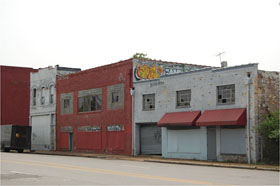 | 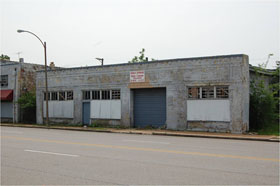 |
2. 4223-29 MLK. Enterprise Cleaning Company. The Ville. The Enterprise Cleaning and Drying Company was established in 1900 and their complex along Easton Avenue, now MLK, was constructed during the first three decades of the twentieth century. The facility contained offices, laundry, boilers, dryers and commercial space. The building is an excellent example of early 20th century commercial architecture with stately sets of pilasters with Doric capitals at each end of the façade and a substantial terra-cotta cornice with classical details. The most eye-catching feature of the building is the large sign, executed in green and white terra-cotta panels, proclaiming the Enterprise Cleaning and Drying Co, which stretches nearly the full length of the façade. While Easton Avenue was once one of the premier commercial strips in the city, today's Martin Luther King has suffered greatly from disinvestment and demolition. The Enterprise building is open to the elements on its façade and is missing large portions of its roof. Despite the problems that MLK faces today, substantial blocks of commercial buildings remain intact presenting the potential for a resurgence of pedestrian and retail life. Furthermore, high-profile projects like the RHCDA's residential and commercial rehabilitations at nearby Dick Gregory Place offer hope that reinvestment in this architecturally significant area is shifting from a hope to a reality.
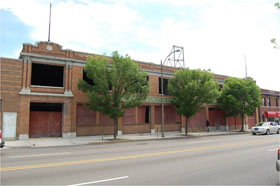 |
3. 4831 Fountain. Built in 1896 as a complex of stores and flats by Edward Keller, this magnificent set of buildings conforms to the curve of Fountain Avenue as it passes Bayard Street. Surrounded by grand, though frequently deteriorating homes and buildings designed by the likes of Barnett, Haynes and Barnett and Albert Groves, Fountain Park (originally Aubert Place) was listed in the National Register by Landmarks Association in 1979; the buildings at 4831 appeared to have been vacant at that time. Currently, the buildings have lost their original pressed metal cornices and major portions of the roof. Masonry in some areas is beginning to fail. Despite this, some in the neighborhood recognize the value of the buildings to the future of the community. The reverend Troy Spencer has been holding fundraisers for several years in the hopes of acquiring the funds necessary to rehabilitate the buildings as a community center. His fundraiser this year is on June 19th at Sherman Park.
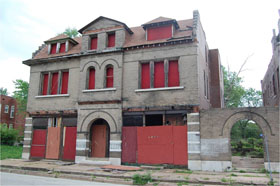 | 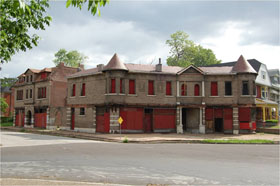 |
4. 1014-1030 Spruce, part of Cupples Station. Designed in 1907 this seven story brick warehouse was listed in the National Register as a component of the Cupples Station warehouse district by Landmarks Association in 1984. Cupples Station was conceived in the early 1880's by Robert Brookings, partner and Vice President of the Samuel Cupples Woodenware Co. Brookings envisioned a collection of freight warehouses and distribution services that were built on land fronting on the major rail lines running east-west through the Mill Creek Valley and interconnected by a web of spur lines. Annually, St. Louis merchants spent massive amounts of money transporting goods from the choked and confusing freight-yards in the wharf area to their scattered warehouses, an inefficient system that Brookings planned to improve. By the turn of the century, the warehouses at Cupples Station were being lauded by the Engineering News, the Brick Builder, the Architectural Record, and Scientific American as a paragon of efficiency and engineering. As the importance of rail freight declined with the rise of air freight and trucking, the complex lost tenants. Several buildings were demolished by the construction of interstate 64 prompting the Society of Architectural Historians to pass a resolution in1968 calling for the preservation of the remaining structures. While several other buildings in this complex have undergone successful and beautiful renovation in recent years as important components of the built environment surrounding Busch Stadium, the building at 11th and Spruce became an unfortunate victim of recent economic turmoil. Major holes in the roof of the building can be seen when approaching Downtown from the south on Twelfth Street and many of the windows are open to the elements.
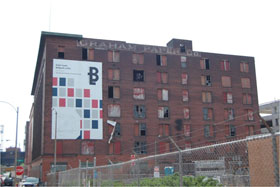 | 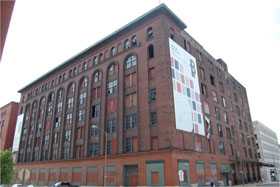 |
5. 1711 Locust. This building was constructed in 1903 as a power substation for the St. Louis Transit Company, one of the major operators of the streetcar system. The architect is unknown, but Martin Arhelger was the contractor. The building was recently auctioned and bought by 1711 Locust LLC. The building has substantial damage to its roof; it is not known what, if any plans the current owners have for the property. Containing a single soaring story, this building possesses an immense and dramatic interior space which could be suitable for many different uses. Paradowski Design's superlative rehabilitation of a similar building serves as an example of how a former generator building can be repurposed in such a way that takes advantage of the open space.
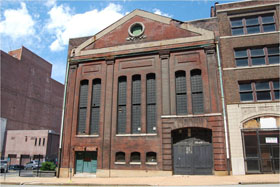 | 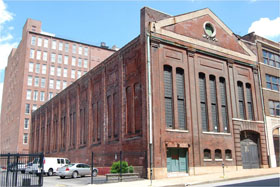 |
6. 2423 N. Spring. Another fabulous building associated with St. Louis' renowned streetcar system. This United Railways Co. substation was constructed in 1906 and designed by Architect William Cann. By the 1920's, the building was listed in city directories as a "trouble station," a use which we have not yet been able to interpret. Cann was a fairly prolific architect in St. Louis around the turn of the century designing several prominent institutional buildings such as the Beethoven Conservatory at 4505 Olive and the Fry Memorial Church in Clifton Heights. This building is all that remains of a substantial group of streetcar-related resources that once stood on Spring in the vicinity of Prairie and N. Market including car sheds, an air compressor building, workers quarters and a power house.
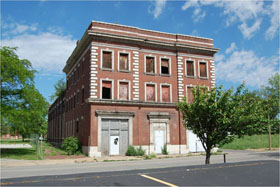 | 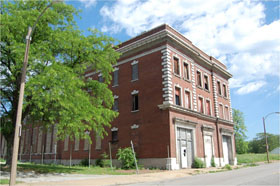 |
7. 1435 Salisbury. This grand and imposing three-story corner commercial/residential building sits at the prominent corner of Blair and Salisbury in Hyde Park. While across the street on either side of Salisbury are similar occupied buildings, this giant is abandoned and owned by the city's cash-strapped Land Reutilization Authority. The building features an intact cast iron storefront, elegant brick corbelling, a pressed-metal cornice and a relatively intact slate mansard featuring an engaged corner tower and thee pedimented dormers. The building is structurally sound, though the fact that most of its windows are completely open to the elements indicates that this may not be the case for long. As with all historic brick buildings, once substantial amounts of water start to penetrate the brick withes, destabilization is quick to follow.
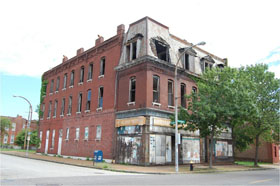 | 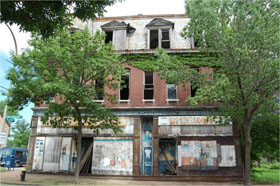 |
8. 3244 Iowa. Just a few blocks from the bustling Cherokee strip sit many of the city's most interesting and diverse historic streetscapes. This side-gabled alley house occupies an unusual position on the lot and its gable-end, alley-side entry exemplifies the unpredictable and often chaotic nature of 19th vernacular development. The small size of this house makes it a fantastic candidate for a low to moderate income rehab and an opportunity to potentially bundle historic tax credits with low-income housing credits. Unfortunately, the structural failure of the central bay and bearing wall may soon lead to collapse or emergency demolition and the city has issued a last ditch call for redevelopment. While not a building possessed of outstanding architectural merit, its plight exemplifies the lot by lot erosion of the historic fabric, which left unchecked degrades the integrity of our outstanding urban streetscapes and often results in a downward spiral for a surrounding property values.
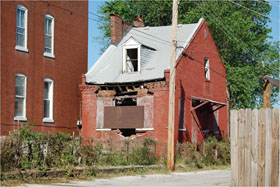 |
9. 3330 Iowa front and alley house. Just down the street from 3244 Iowa in Benton Park West is another set of endangered buildings which illustrates the relationship between primary residence and alley house that has been lost on its neighbor up the street. The primary building was likely built in the early 1880's as a two-family residence. A gangway on the right side of the façade becomes a mousehole as the upper stories extend to be flush with the neighboring sidewall toward the rear of the building. This creative way of adding additional living space to the upper stories illustrates the infinite variety found in neighborhoods that were built house by house by different contractors and craftsmen. The building retains a rare two-story brick alley house, most of which have disappeared from the city. Alley houses were usually built by property owners as rental units to take advantage of the extra space at the rear of deep city lots. As secondary structures they are usually substantially smaller than the primary residence and frequently fall by the wayside as a neighborhood evolves- many were demolished for garages and parking space in the 20th century. The masonry walls are beginning to fail at the rear of the main building and the open condition of many windows on both buildings is allowing moisture to get in between the withes of the brick walls. While still structurally sound, these buildings will not withstand many more freeze-thaw cycles and mortar dissolving downpours.
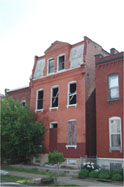 | 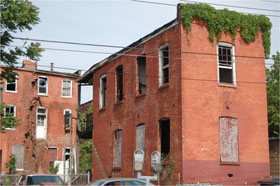 |
10. St. Louis Housing Authority Building. 4100 Lindell Boulevard. The St. Louis Housing Authority has recently executed a new option with CVS pharmacy who is interested in demolishing the building for a new pharmacy location to compete with the nearby Walgreens. According to Michael Allen, "the St. Louis Housing Authority's three-story modern building began life in 1956 as the St. Louis office of the Sperry-Rand Corporation. The architect was then-fledgling Hellmuth Obata & Kassabaum. The Sperry-Rand Building is derived from International Style principles, especially the neutral colors, the recessed floors, the concrete piers, wide large windows and the applied outer metal bars. While not as accomplished as the firm's later National Register-listed Plaza Square Apartments, this is a fine building and a subtle component of the group of modern buildings on Lindell Boulevard west of Grand Avenue. Its loss, especially at the hands of a public entity, would be a blow to the already-threatened modern landscape of Lindell Boulevard." Eco-Absence, 7/15/09 http://ecoabsence.blogspot.com/2009/07/st-louis-housing-authority-building-to.html
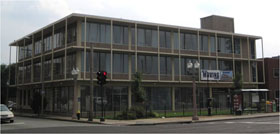 |
11. The Admiral. Built in 1907 as a sidewheel steamer called the S.S. Albatross in Dubuque Iowa by Dubuque Boat and Boiler Company. She was originally used by the Louisiana and Mississippi Valley Transfer company to transport up to 16 loaded railroad cars in the vicinity of Vicksburg. In 1937 the ship was bought by Streckfus Steamers Inc. and brought to St. Louis to serve as an excursion boat. At that point the ship underwent a major overhaul that completely changed the appearance from paddlewheel steamer to the Art Deco streamliner we know today. In light of the rebuilding, the ship was re-christened as the Admiral. It was noted at the time that the boat was the largest river cruiser in the world and the first Mississippi riverboat to be fully air-conditioned. The Admiral's fortunes declined with the city in the latter half of the 20th century and in 1979 her engines were removed and the ship was permanently moored to the St. Louis wharf. In the 1990's the boat was converted into the President Casino. In 2010 the Missouri State Gaming Commission voted to revoke the casino's license due to declining revenue and the facility is slated to close this July. With no buyer in sight, the Admiral may be headed for the scrap yard.
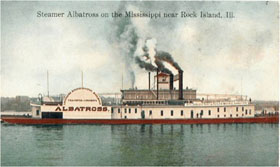 | 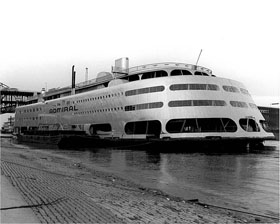 |
12. Bohemian Hill. Roughly bounded by 13th, Lafayette, Tucker, and Soulard Street. Named in the last decade for its proximity to the parish complex of St. John Nepomuk, the earliest Bohemian Catholic parish in the United States, the 16 remaining historic buildings in the isolated little group to the west of Tucker have not fared well in the last few years; fully one third are vacant and deteriorating. Once a hilltop location valued enough for its view and breeze to have boasted the legendary mansion of Henry Soulard, today this largely neglected pocket stands isolated by the destruction wrought by Interstate 44, the large-scale clearance of most of LaSalle Park, and the abortive experiment of the Darst-Webbe housing project. While nearby neighbors in Soulard and Lafayette Square flourish, the relative isolation of these buildings resulted in their exclusion from surrounding historic districts and thus from attendant redevelopment incentives. This little group on Bohemian Hill serves as a cautionary example for planners and preservationists about the importance of thinking long and hard about the boundaries of historic districts.
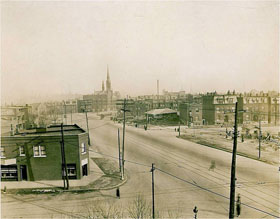 |
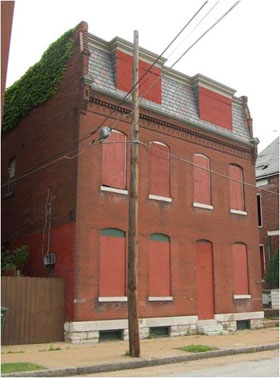 | 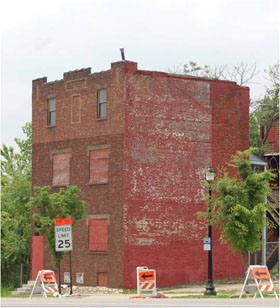 |
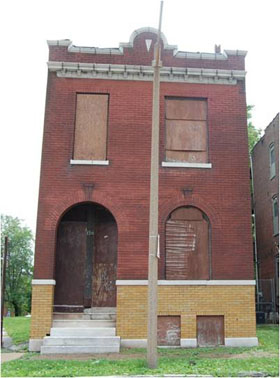 | 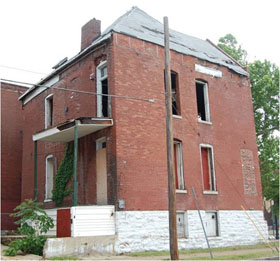 |
